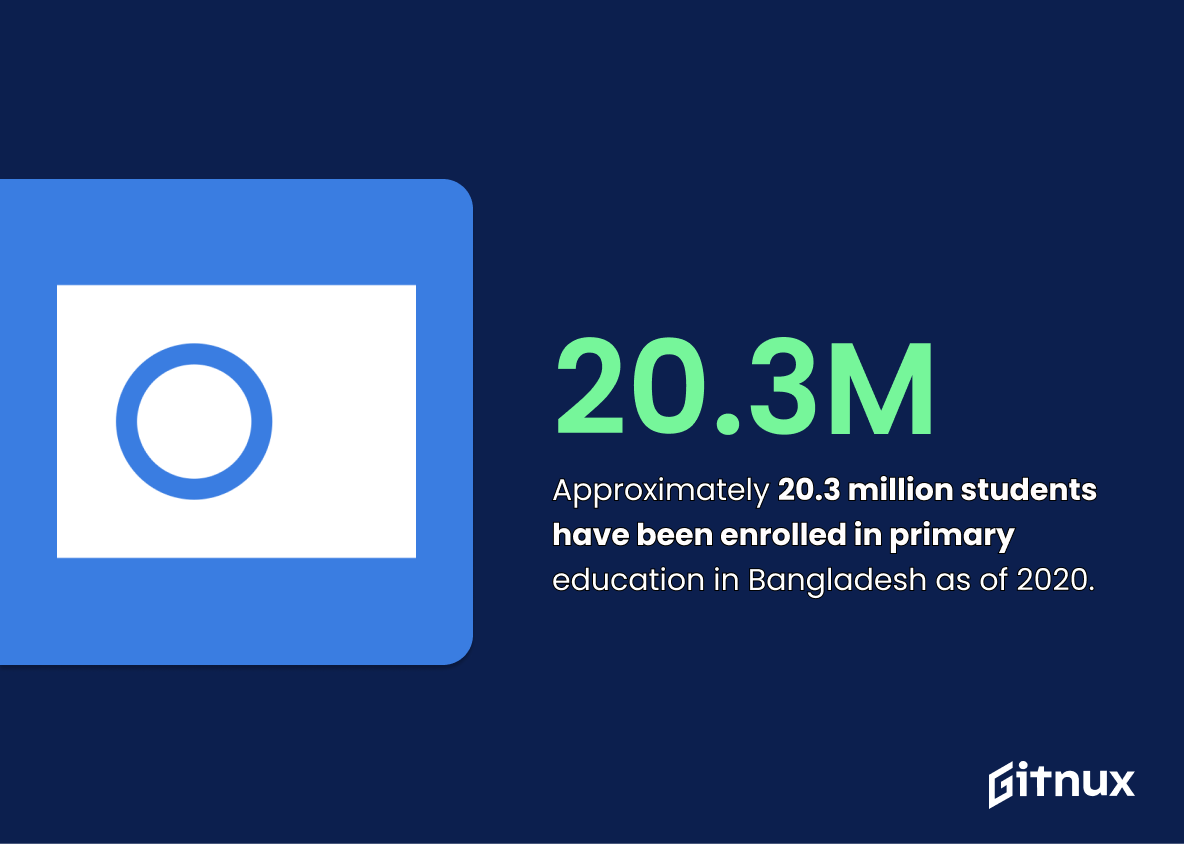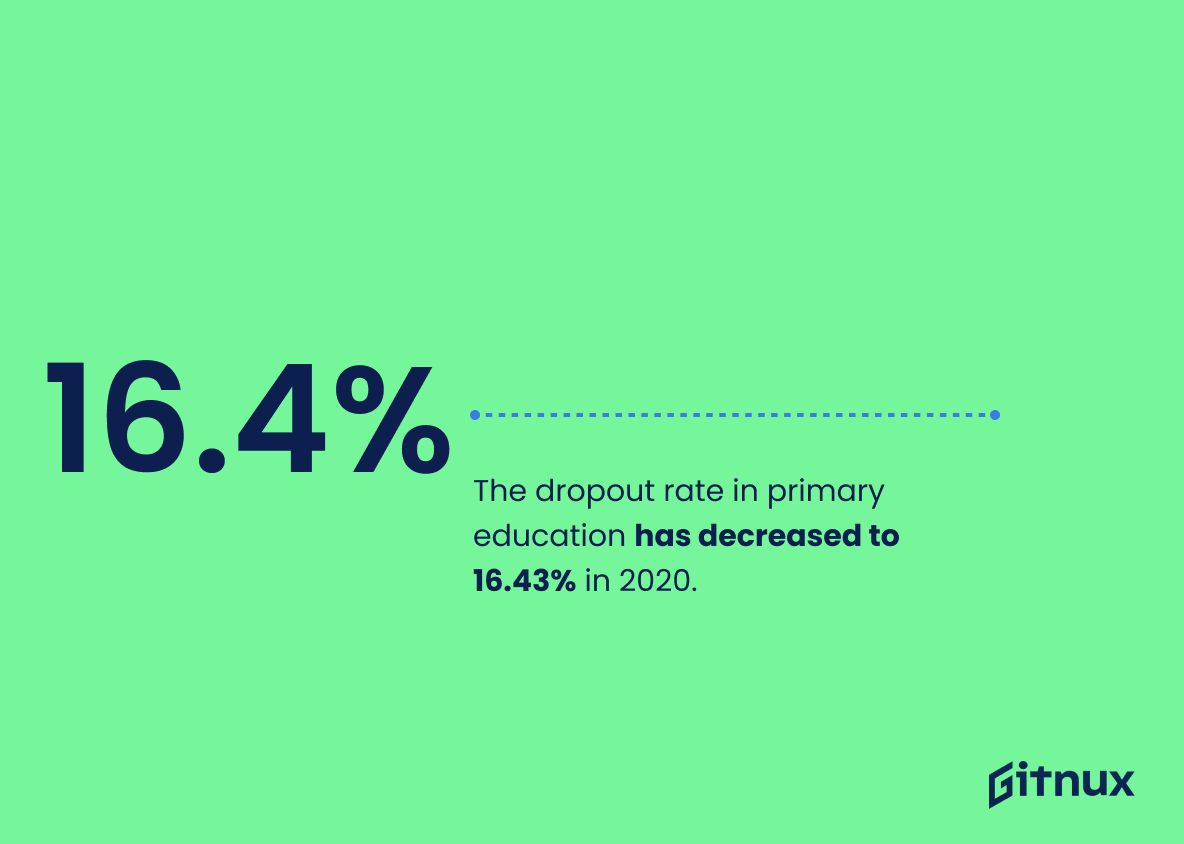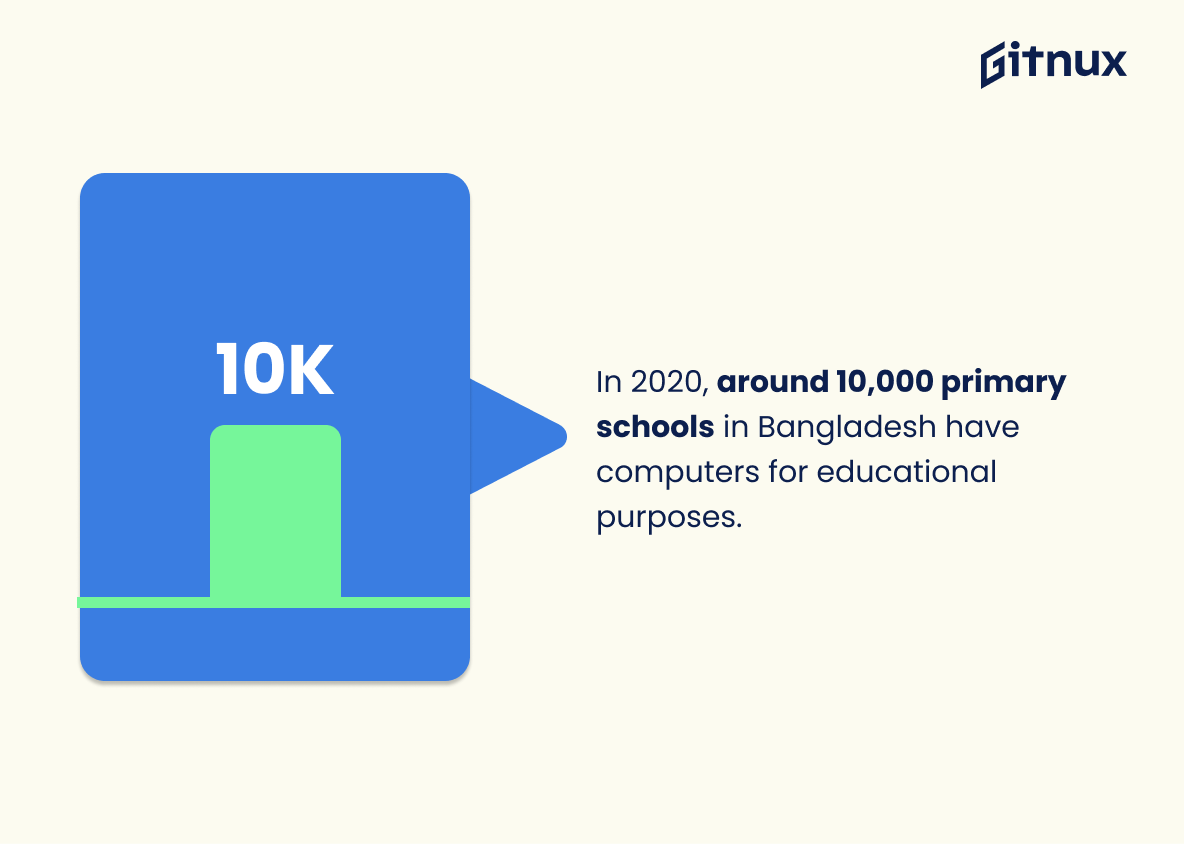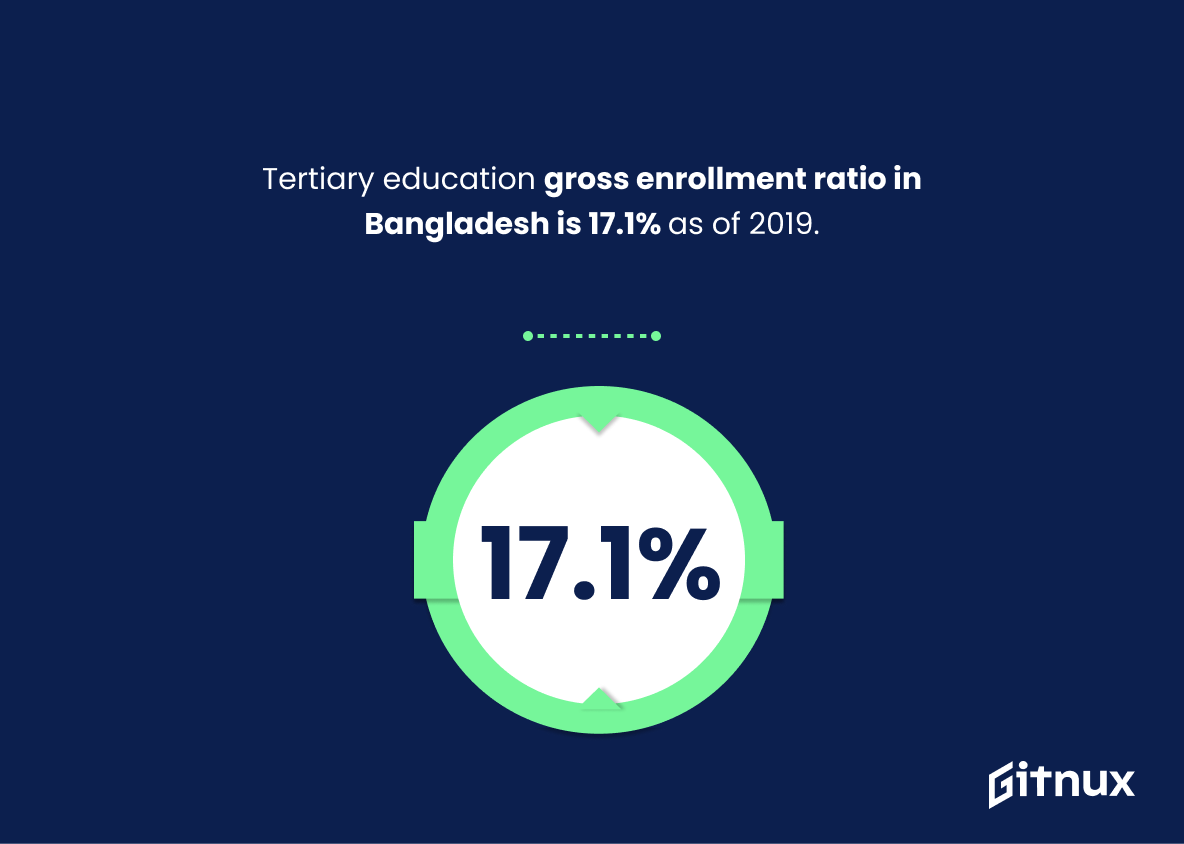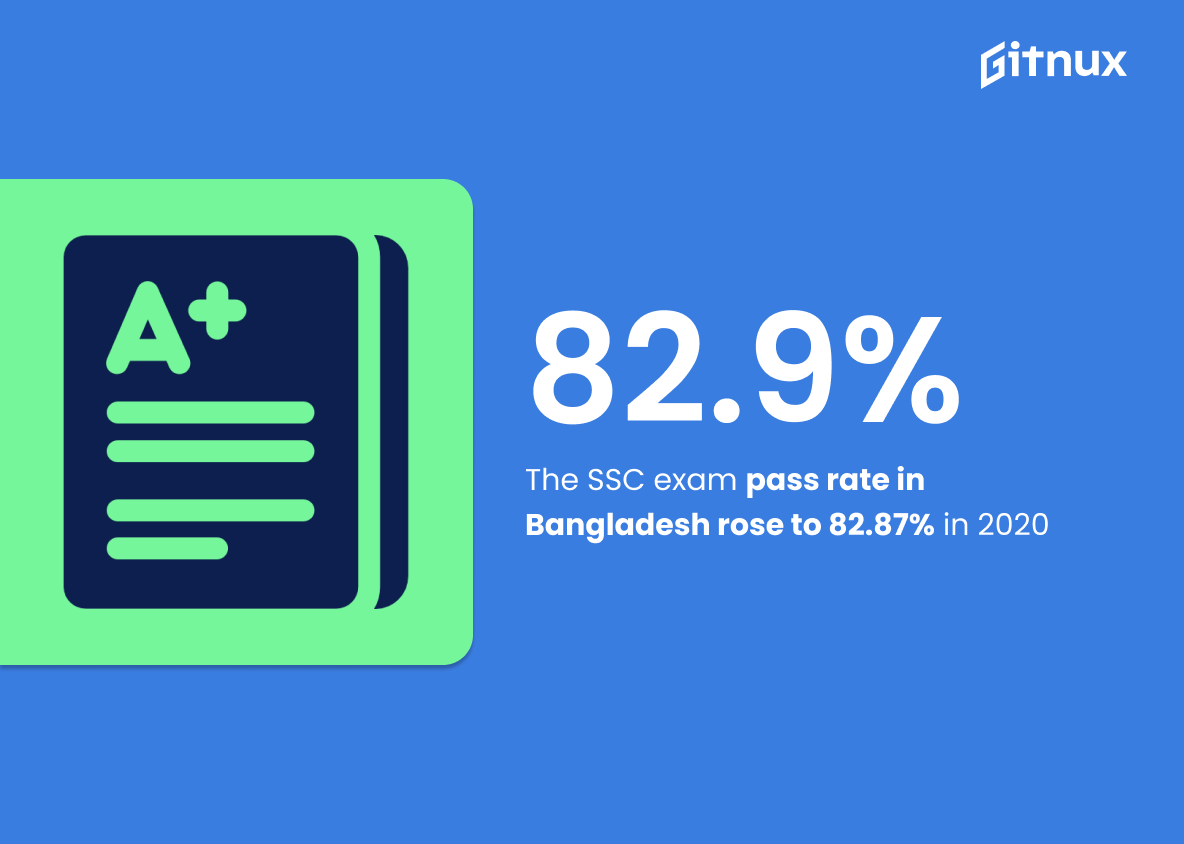Bangladesh has made significant progress in the field of education over the past few decades. According to recent statistics, literacy rate in Bangladesh has increased from 46% in 1991 to 74.7% in 2020 and net enrollment rate for primary education reached 97.84%. Gross enrollment ratio for secondary education is 61.1%, while tertiary gross enrollment ratio stands at 17.1%. Education expenditures were 2.09% of GDP as per 2019 data and government allocation for the sector was 14.6% of total budget during fiscal year 2019-20 . Girls’ and boys’ enrolment rates are 9737 %and 9831 % respectively, with a dropout rate decreasing to 1643%. Approximately 20 million students have been enrolled into primary schools which number 84997; student teacher ration being 30: 1 . There are 20632 secondary schools with 439 766 teachers (59%:41%) out of which 10 000 have computers installed for educational purposes.. The pass rate on Secondary School Certificate exams rose up to 82 87 %in 2020 These figures demonstrate that Bangladesh’s efforts towards improving its educational system have paid off significantly over time
This statistic is a testament to the remarkable progress Bangladesh has made in primary education. With a net enrollment rate of 97.84%, Bangladesh has achieved a level of educational access that is the envy of many countries. This is a major milestone in the country’s journey towards providing quality education to all its citizens.
Bangladesh education expenditures were 2.09% of GDP in 2019.
The statistic that Bangladesh education expenditures were 2.09% of GDP in 2019 is a telling indicator of the country’s commitment to education. It speaks to the level of investment that the government is making in the education system, and the importance it places on the development of its citizens. This statistic is an important part of understanding the state of Bangladesh’s education system, and how it is evolving over time.
Bangladesh Education Statistics Overview
Approximately 20.3 million students have been enrolled in primary education in Bangladesh as of 2020.
This statistic is a testament to the progress Bangladesh has made in providing access to primary education for its citizens. It is a sign of the country’s commitment to providing quality education to its people, and it is a source of pride for the nation. It is also a reminder of the importance of continuing to invest in education, so that more children can benefit from the opportunities it provides.
Secondary School Completion Rate in Bangladesh is 58.09% as of 2019.
The Secondary School Completion Rate in Bangladesh is a telling statistic when it comes to the state of education in the country. It serves as a barometer of the educational opportunities available to the people of Bangladesh, and the progress that has been made in recent years. This statistic is a reminder that there is still much work to be done in order to ensure that all citizens of Bangladesh have access to quality education.
The dropout rate in primary education has decreased to 16.43% in 2020.
This statistic is a testament to the progress Bangladesh has made in improving its primary education system. It shows that the country is taking steps to ensure that more children are able to access quality education and stay in school. This is an important step towards achieving the country’s goal of providing quality education to all its citizens.
In 2020, around 10,000 primary schools in Bangladesh have computers for educational purposes.
This statistic is a testament to the progress Bangladesh has made in providing educational resources to its primary schools. It shows that the country is committed to providing students with the tools they need to succeed in their studies. By having access to computers, students can gain a better understanding of the world around them and develop the skills necessary to succeed in the 21st century. This statistic is a positive sign for the future of education in Bangladesh.
Tertiary education gross enrollment ratio in Bangladesh is 17.1% as of 2019.
The statistic that tertiary education gross enrollment ratio in Bangladesh is 17.1% as of 2019 is a telling indication of the state of education in the country. It highlights the fact that despite the country’s efforts to improve access to education, there is still a long way to go before Bangladesh can achieve its educational goals. This statistic serves as a reminder that there is still much work to be done in order to ensure that all citizens have access to quality education.
The pass rate of Secondary School Certificate (SSC) exams in Bangladesh has increased to 82.87% in 2020.
This statistic is a testament to the hard work and dedication of the students, teachers, and administrators of Bangladesh’s secondary schools. It is a sign of progress and a beacon of hope for the future of education in the country. It is a reminder that, with the right resources and support, Bangladesh can continue to make strides in improving the quality of education for its citizens.
Conclusion
The statistics presented in this blog post demonstrate that Bangladesh has made significant progress in the field of education over the past few decades. Literacy rate has increased from 46% to 74.7%, net enrollment rate in primary education reached 97.84%, and gross enrollment ratio for secondary education is 61.1%. Education expenditures were 2.09% of GDP, girls’ and boys’ enrollment rates are 97.37% and 98.31%, respectively, while student-teacher ratio stands at 30:1 as of 2019/2020 academic year period . Approximately 20 million students have been enrolled in primary schools with 84,997 total number of institutions across the country; whereas there are 20,632 secondary schools with 439,766 teachers employed by them as well as a 58 percent completion rate among those attending these educational facilities . The percentage of female teachers is 59 percent compared to 41 percent male counterparts , dropout rate decreased to 16 % , 40 % youth aged 15-24 attend school or training programs , 14 % government budget allocation was allocated towards educational sector during fiscal year 2019 – 2020 ; 10 thousand computers installed within primary schools for educational purposes & 82 87 passrate achieved on SSC exams conducted throughout 2020 . All these facts point out that Bangladesh’s efforts towards improving its overall quality of education system have paid off significantly over time which will continue into future years if current trends remain consistent..
References
0. – https://www.globalpartnership.org
1. – https://www.bdnews24.com
2. – https://www.worldometers.info
3. – https://www.dhakatribune.com
4. – https://www.apps.who.int
5. – https://www.thedailystar.net
6. – https://www.data.worldbank.org
